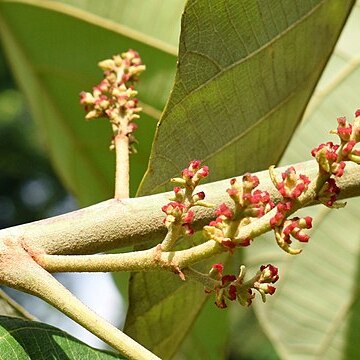Small trees 3-15 m tall. Branchlets ferruginous or yellowish brown tomentose when young; branches glabrous, sometimes glaucous. Stipules lanceolate, 7-8 mm, tomentose, caducous; petiole 5-20 cm; leaf blade deltoid-ovate or broadly ovate, 12-30 × 11-28 cm, thinly leathery or thickly papery, abaxially pubescent, densely glandular scaly, adaxially glabrescent, base obtuse or subtruncate, narrowly peltate, rarely subcordate, with 2 or 4 glands, margin repand or subentire, apex cuspidate-acuminate, palmately 7-9-veined. Male inflorescences branched, 5-10 cm, tomentose; bracts suboblong, 2-3 mm, margin 2-4-glandular, or triangular, ca. 1 mm. Male flowers 3-7 per bract; pedicel ca. 0.5 mm; calyx 2-or 3-lobed, ca. 1 mm; stamens 9-16(-21). Female inflorescence branched, 4-8 cm, tomentose; bracts oblong or ovate, leaflike, 5-7 mm, margin 2-6-glandular, or triangular. Female flower solitary; calyx cup-shaped, 2-lobed, ca. 1.5 mm; ovary 2(or 3)-locular, puberulent; styles 2(or 3), ca. 1 mm. Fruiting pedicel 3-5 mm; capsule 2-lobed, 5-6 mm in diam., densely glandular-scaly; persistent calyx 3-or 4-lobed. Fl. Apr-Jun, fr. May-Oct.
More
An evergreen tree. It grows 18 m tall. The trunk has shield shape leaf scars. The twigs are angled. The leaves are simple and alternate. They have red-brown hairs underneath. There are many flowers in a group. The male and female flowers are on different trees. The fruit are 8 mm long. They are capsules that split open in 2 sections. They are 2 seeds with a thin orange aril or fleshy layer around them.


